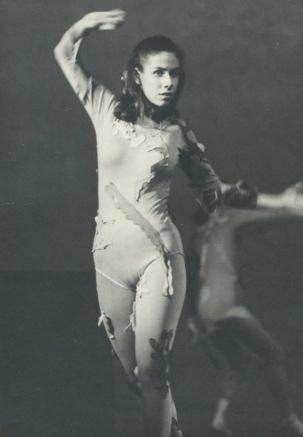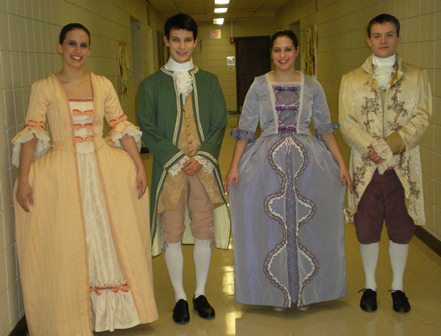by Gillian Ellis

Last month, more than 400 college dancers gathered at OU for the East-Central American College Dance Festival Conference. It was the 40th anniversary conference and, to the best of our knowledge, only one of this year’s attendees was able to claim that she was also there at the very first one.
That dancer was our very own
Debi Bernstein-Siegel, who is retiring this semester after almost twenty years of service to the OU dance program. It’s so long, Debi says, that she would have to check her records to be sure just how many years it is. She first began to teach at OU when
Carol Halsted, who is now director of dance at Michigan Opera Theatre, was chair of the department. Carol needed someone to teach some of her dance classes and asked Debi to do it.
Debi was already teaching at Marygrove College, and for a while she managed both part-time gigs, but she is happy she decided to focus on OU and devote her time to helping energize the dance program. “There has been such an amazing growth in the program,” she says. She believes the introduction of the B.F.A. degree and the skill and passion of the dynamic and creative faculty have raised the barre (pun intended!) for our dance majors.
She also notes that these same young dancers are fearless in using modern technology to choreograph, dance and promote their work. “The model is changed from when I graduated. These young dancers don’t wait to be hired by a company anymore.”
Debi grew up in Chicago and she attended The Ohio State University, where her parents expected she would be a history major, but she had danced all her life and she felt its call too strongly to resist. She graduated with a B.F.A. and set out for Los Angeles. “I felt like a fish out of water,” she says, and deciding she was not a California girl after all, just one year later, she returned to Ohio State and took a graduate assistantship to work on an M.A. She also danced with Dancecentral, a company in Columbus, Ohio.
While working on her master’s degree, Debi found herself drawn to areas of dance other than performance. She had never lost her love of history and she spent a lot of time researching the history of dance. “I might have focused on that area for my masters,” she says, “if such a thing had existed at that time.” She was also becoming interested in the role dance could play in therapy.
Once her graduate degree was completed, she would occasionally spend time in New York, trying out for a company or a show, but she devoted a lot of time to working as a dance movement therapist, even seeking grants to get this important work off the ground in some institutions.
This kind of work is done in clinical situations with elderly patients or with those who have psychological issues. Debi has worked in all kinds of locations. The dance she offered was never choreographed, but rather she says, “It is always an opportunity for self-expression at the intersection of psychology and kinesthetics.” She would use techniques such as improvisation, mirroring and witnessing.
Debi says that for the elderly, this kind of therapy can be transformative. “It can be like a door opening for them.” Adolescents can be resistant, but she says the key is “to meet them where they are,” for example, working with the kind of music that they are listening to. She likes her current OU students to know that this kind of work is still a career option.

When she first came to OU, Debi was teaching freshmen modern dance and improvisation. She continued to teach improv until very recently, but as the dance program evolved, she added classes on academic topics such as Dance History, which she had loved and studied for a long time. Debi brought the research from this class alive and to the stage, with members of the Oakland Dance Theatre performing choreographed Baroque dances wearing accurate period costumes. It is a dance style from before ballet evolved, and she believes it gives the students some context to understand the development of ballet.
She also teaches three other academic dance classes and a few years ago, led the way for the dance program, launching their first ever online dance class, “Dance History and Appreciation.” The first to admit she was a reluctant participant when this was first proposed, Debi now says, “It was a gratifying educational experience. I was shocked! There is a lot of student engagement.”
As she retires, Debi surveys a dance program that has transitioned into a dynamic and creative force in the region, knowing that she has played a major role in that evolution. She hopes that the academic aspect of dance education at OU will become ever more rigorous, so our students can continue to meet new challenges.
“It’s been a really great run,” says Debi but, of course, she hasn’t really moved off the track yet. Debra Bernstein-Siegel is president of the board of the Eisenhower Dance Ensemble, and she serves on the board of the Detroit Opera House and the Great Lakes Chamber Music Festival. Her impact on the region’s performing arts scene is going to be felt for some time yet, but for all she has done for OU Dance, we say thank you. We will miss you.
Photos: Upper: A photo of Debra Bernstein-Siegel from her own collection. Photo by W.B. Nickerson Photography.
Lower: Dance students (left to right) Amber Klaus, Brett Wotherspoon, Alex Woynick and Matthew Wagner in costume for their Baroque dance "Playground of Possibilities." Women's costumes designed and constructed by Willow Lupa. Photo by Debra Bernstein-Siegel.

 Last month, more than 400 college dancers gathered at OU for the East-Central American College Dance Festival Conference. It was the 40th anniversary conference and, to the best of our knowledge, only one of this year’s attendees was able to claim that she was also there at the very first one.
Last month, more than 400 college dancers gathered at OU for the East-Central American College Dance Festival Conference. It was the 40th anniversary conference and, to the best of our knowledge, only one of this year’s attendees was able to claim that she was also there at the very first one.  When she first came to OU, Debi was teaching freshmen modern dance and improvisation. She continued to teach improv until very recently, but as the dance program evolved, she added classes on academic topics such as Dance History, which she had loved and studied for a long time. Debi brought the research from this class alive and to the stage, with members of the Oakland Dance Theatre performing choreographed Baroque dances wearing accurate period costumes. It is a dance style from before ballet evolved, and she believes it gives the students some context to understand the development of ballet.
When she first came to OU, Debi was teaching freshmen modern dance and improvisation. She continued to teach improv until very recently, but as the dance program evolved, she added classes on academic topics such as Dance History, which she had loved and studied for a long time. Debi brought the research from this class alive and to the stage, with members of the Oakland Dance Theatre performing choreographed Baroque dances wearing accurate period costumes. It is a dance style from before ballet evolved, and she believes it gives the students some context to understand the development of ballet.